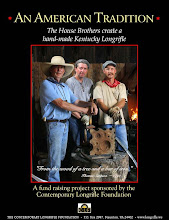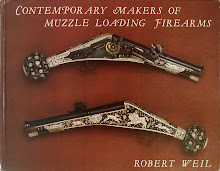Brooklyn, Michigan residents Wayne and Marilyn Holcombe are
silversmiths by trade and operate XX Trade Silver.
XX Trade Silver began 10 years ago when their close friend, Chuck
Leonard, a premier silversmith taught them the art of silversmithing. Wayne
chuckles when he relates how it all started.
“I was involved with competition black powder shooting
and Marilyn accompanied me to a lot of shoots through the years. One day Marlyn
mentioned to Chuck Leonard that she got bored at the shoots so Chuck told her
that he would show her something that will make it a little more interesting.
At that time Marilyn started her study of silversmithing and I came under the
spell, too. Under the guidance of
Chuck, we have developed our art, started our company and have become regulars
on the Living History and Trade Fair circuits. When we're not on the road, we
call Brooklyn, Michigan home.”
Before the husband and wife team learned the silversmithing
trade and launched their business, Wayne worked with master gunmaker and wood
carver John Bivins in Raleigh, North Carolina during the ‘90s. Together they did museum restoration
and carved colonial period high-art wood installations for museums and private
clients.
After returning to Michigan, Marilyn and Wayne began their
research and schooling in the art of silversmithing and both attribute Chuck
Leonard as their inspiration to become silversmiths.
They work in sterling silver specializing in the re-creation
of authentic trade silver pieces from the early 18th century to present. All of
their silver is period correct, by using the same tools and processes as the
original silversmiths. They also create their own designs upon request. And as
Wayne and Marilyn put it, “We do lots of custom orders.”
The silver wrist band is an
interpretation from one that came from a site in East Tennessee. It has the
same type of markings found on the trade silver “shells or "moons" and
has the words “South Carolina” engraved on it which could be possibly an item
from a South Carolina treaty with the Creeks and Cherokees. It would make a nice
companion piece to the “South Carolina” trade silver “Shell” made by the Wayne
and Marilyn and also offered in the auction.
IN REMEMBRANCE OF CHUCK LEONARD 1939 - 2005
Chuck Leonard was an exceptional silversmith, historian and a fine person as well. Years ago he wrote this short history of trade silver. We thought we would include it for all to read.
The story of trade silver begins in the 1500's with the Native Americans and the seasonal fishing boats coming from Europe. The crew members of these boats traded their personal items, such as cloak brooches, Lukenbooth pins, crosses and Masonic pins to the inhabitants of the New World for whatever the natives had to offer, mainly fur pelts. These silver pieces coming from across the Atlantic were high quality, finely detailed pieces of sterling silver, made by British silversmiths.
These appealed to the natives and became the focus of the developing silver trade. The designs changed slightly over the years and the cross and the Masonic brooch gradually lost their religious significance. Armbands, wristbands, gorgets, finger rings, effigies and hat bands were added to the list of trade silver items brought for trade. Another major item, the ball and cone earring, emerged in the early 1700's. This type of earring was perhaps the most common item of the silver trade.
In primitive cultures the wearing of one's wealth is common. So it seems natural that the American natives (and the whites in contact with them) wore hundreds of brooches of various patterns to decorate their clothing. The ball and cone earrings were worn in multiples, not only in the ears, but also hung on the brooches to make a kind of bell. The brooches themselves were secured to the cloth by a tongue-like fastener, which made the silver easily removable for trade. Trade silver was readily spendable.
From 1725 until about 1825 the silver trade expanded greatly. Silver became one of the dominant items of the fur trade. During this period, high quality trade pieces were being manufactured in great numbers by silversmiths in Montreal, Philadelphia, Detroit, Chicago, St. Louis, etc. The use of maker's marks by these craftsmen makes it possible to trace these pieces back to maker, location and date. These early craftsmen used hand-made iron punches, chisels and saws to cut the intricate designs. Then they finished the piece by hammering the silver on a polished iron block (doming), filing, polishing and lastly, engraving. The predominant material in this period was silver. This silver was available from many sources, one of which was the silver coins that circulated in the larger cities. The silver content of these coins ranged from 60-95.8% silver.
By the early 1800's, the beaver population was depleted in the East and the Old Northwest and traders were moving west of the Mississippi River to obtain the pelts. The thirst for trade silver was successfully transplanted to the West by these traders and their Indian and half-breed families. East of the Mississippi, with the traders gone, the Indians themselves began making silver pieces. They used slightly different methods of construction. Less intricate designs resulted, because of heavy reliance on the saw. Doming was less prevalent and there was little need for filing. Most of the Indian pieces were considered finished at this stage, as engraving was seldom done.
After 1870 the most common material used was a silver colored metal called German or Nickel silver. This metal consists of an alloy of nickel, copper and zinc and contains no silver at all, but it does have a shiny surface. Although German (Nickel) silver came into this country during the early 1800's, it was not obtainable in sheet form before 1838 and does not appear to have been used as a substitute for sterling in trade silver until after 1850.
The use of trade silver has declined since the mid 1800's. It is, however, still made by a few silversmiths, trade re-enactors and Indian traditionalists for their clothing.
To see more of Wayne and Marilyn’s work visit their website, XX Trade Silver.
Copy and photos supplied by the Contemporary Longrifle Foundation.


































.jpg)
.jpg)
















































